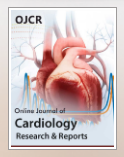Authored by Eriston Vieira Gomes*
Abstract
Pericarditis is an inflammatory process that affects the layers of the pericardium. It is characterized by chest pain and electrocardiogram changes and may be followed by pericardial effusion and rub. Here, we aimed to identify the main clinical diagnosis criteria and therapeutic management approaches of pericarditis, its variants, and related complications.
Keywords: Pericarditis; Pericardium; Inflammation; Heart disease
Abbreviations: ECG: Electrocardiogram; CRP: C-Reactive Protein; NSAID: Nonsteroidal Anti-Inflammatory Drugs; IRP: Idiopathic Recurrent Pericarditis
Introduction
Pericarditis is a syndrome caused by pericardial (visceral and parietal pericardia) inflammation and is the most common pericardium-related disease. It may be categorized as acute (symptoms last for less than 4 weeks), recurrent (symptoms persist for 4 and 6 weeks), incessant (symptoms persist for more than 6 weeks), or chronic (symptoms persist for more than 3 months) [1- 3]. Pericarditis is caused due to different factors, such as infectious causes (viral or bacterial, viruses being the most prevalent cause in developed countries and tuberculosis being the most prevalent cause in developing countries), or noninfectious causes, such as myocardial infarction, malignancy, trauma, autoimmune disorders, or idiopathic diseases [2, 4-6].
Clinical Features and Diagnosis
According to the current European Society of Cardiology guidelines [7], it is necessary to meet at least two of the four defined criteria for diagnosis. The most common criterion is chest pain (which may radiate to the shoulders, arms, and jaw), pericardial effusion (found in 60% of cases), electrocardiogram (ECG) changes, and pericardial rubs (observed in about 33% of cases) [7,8]. Moreover, other clinical signals (e.g., elevation in levels of C-reactive protein [CRP], white blood cell count, etc.), and imaging techniques could also be employed for both diagnosis and monitoring of the disease [2,7].
Treatment
The first-choice therapy for patients with acute and recurrent pericarditis is administration of nonsteroidal anti-inflammatory drugs (NSAIDs) plus colchicine (which shows an anti-inflammatory effect). Considering a non-idiopathic etiology, besides the specific causal treatment (i.e., antimicrobial specific to the etiologic agent), it is recommended that it be associated with an anti-inflammatory agent for symptom control. For specific clinical conditions (see the indicated references), corticosteroids are the next logical choice; however, they have been associated with the risk of relapses [2,8,9]. IL-1 blockers (e.g., anakinra) have been used as viable therapeutic agents for autoinflammatory diseases and could potentially be used for treatment of idiopathic recurrent pericarditis (IRP). Immunosuppressive therapy may be recommended for the IRP patients who either are not responsive or exhibit severe side-effects to corticosteroids [2, 10-12]. For refractory cases, pericardiectomy should be considered; however, this procedure accompanies 5-10% mortality rate [1,12]. Exercise restriction is critical and highly recommended for all cases (Figure 1).
Complications
The major pericarditis-related complications include constriction (adhesive or fibrocalcific response, limiting diastolic filling, dissociation of intracardiac and intrathoracic pressures, and heightened ventricular interdependence) and cardiac tamponade (characterized by an equal elevation of atrial and pericardial pressures, pulsus paradoxus [exaggerated expiratory decrease in aortic systolic pressure] and arterial hypotension) [3,13].
Conclusion
Fast and accurate diagnosis of acute pericarditis, followed by the employment of a safe and efficient treatment approach, may considerably decrease the risk of recurrences and consequent cardiac complications.
To know more about our Journals....Iris Publishers





No comments:
Post a Comment